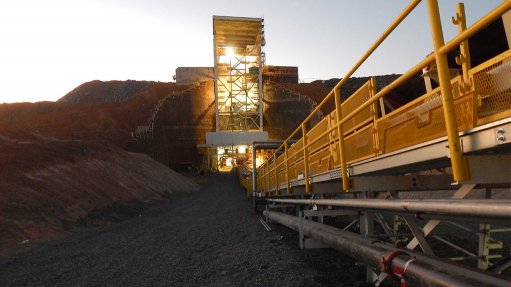
Solar power will provide 20% of the power at the Tasiast site (pictured).
Canadian gold miner Kinross has announced a $55-million investment in a photovoltaic solar power plant at its Tasiast mine, in Mauritania, as part of the group’s efforts to reduce its greenhouse gas (GHG) emissions.
The plant, with its power generation capacity of 34 MW and 18 MW battery system, would be integrated with the mine’s power generation suite, providing about 20% of the site’s power, Kinross said in a statement on Wednesday.
Site activities, such as geotechnical drilling for solar panel foundations, will start in the second quarter of this year, with the plant scheduled to be completed in the September quarter of next year.
Kinross stated that the solar investment would reduce GHG emissions by up to 50 000 t/y, or about 530 000 t over the life-of-mine (LoM), saving about 180-million litres of fuel over that period.
The Tasiast solar investment forms part of the $50-million that Kinross budgeted for environmental, social and corporate governance-related capital expenditures for 2022, the balance including a potential power line to connect the Udinsk project into the regional grid in Russia, reducing the operation’s reliance on using diesel for electricity generation, the miner reported.
Kinross has committed to a goal of being a net-zero GHG emissions company by 2050 and has set a target to achieve a 30% reduction in intensity per ounce produced of Scope 1 and Scope 2 emissions by 2030.
TASIAST EXPANSION
Meanwhile, Kinross reported that despite a mill-fire production setback in 2021, the $150-million expansion project at Tasiast was continuing to schedule and that it would reach throughput of 21 000 t/d (Phase 1) by the end of March, and 24 000 t/d (Phase 2) by mid-2023.
Kinross has restarted the Tasiast mill during the second quarter and completed a successful recommissioning with no material mechanical issues encountered. In the fourth quarter, the site achieved its production target of 15 000 gold-equivalent ounces, after re-starting the plant processing lower grade stockpile ore. Throughput gradually ramped up during the quarter, with the mill reaching throughput of 19 000 t/d to 20 000 t/d in January on a sustained basis.
At a throughput capacity of 24 000 t/d, Tasiast will produce an average of 536 000 oz/y at an all-in sustaining cost of $560/oz.
The 24k project incorporates efficiencies in areas of maintenance, mining, supply chain and processing, as well as modification to the existing grinding circuit, additional leaching and thickening capacity and incremental additions to on-site power generation and water supply. The addition of a new larger ball mill is no longer required, as the project optimises the grinding circuit.
The project is expected to extend the LoM of Tasiast to 2033.
Tasiast has proven and probable reserves of 112.47-million tonnes, grading 1.8 g/t for 6.4-million ounces. Proven reserves amount to 48.56-million tonnes at 1.3 g/t for 63.91-million ounces. Total measured and indicated resources, excluding proven and probable reserves, are estimated at 69.78-million tonnes at 1.2 g/t for 2.59-million ounces.
EXPLORATION COMMITTMENT
Further, Kinross committed to spend $10-million in exploration at licences located near Tasiast in the next three years, with $5-million budgeted for this year.
The company last month had reached an agreement with Mauritania regarding two licenses located west, east and north of the main Tasiast operation.